Oct 10, 2016 End of Summer – Program Reflections
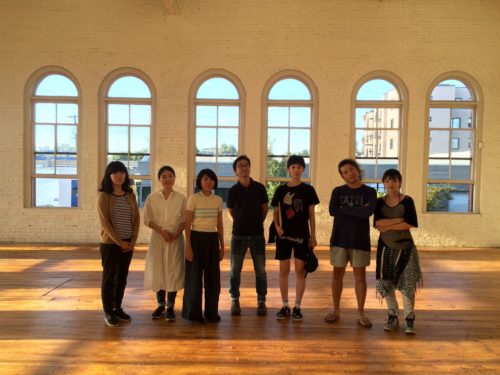
In August 2016, End of Summer successfully welcomed seven Japanese artists to Portland, held three public art lectures by esteemed international scholars, conducted numerous group visits to artists studios, exhibitions, historical sites and cultural centers, organized one open studio event, and held one group roundtable discussion. It was the first iteration of the annual program, and the culmination of a two year development process with Imprint Culture Lab.
The core focus of the residency was to foster and facilitate meaningful personal ties between the Japanese artists themselves, and with the Portland community into which they were immersed. This was enacted through both organized and organically generated visits with diverse local artists, community organizers, independent art spaces, cultural centers and other creative practitioners. Through a conscious effort to make these interactions un-didactic but full of sharing, open, and hinged on personal conversations, I feel we were successful in achieving the sought after but elusive goal of inviting real human connection.

This was first illustrated to me in the most simple but direct way, when three weeks into the residency, one of the Japanese artists remarked to our Program Assistant that it “feels like a family”. It is this directness of affect which End of Summer is interested in as a thematic, even political gesture to encourage cross-cultural understanding and exchange, especially outside of the Western dominated narrative.
What we found was that by diverting emphasis of the program from artistic production to community immersion, interpersonal connection and critical artistic dialogue, the desire to create artwork on the part of the artists seemed to burn especially bright as a result. A strong natural balance developed during the program between the artists working in the studio and participating in activities with the community outside of the studios.
Each of the seven Japanese artists implemented their individual processes of research and experimentation to arrive at their residency projects. In many cases, these projects grew naturally out of the artists’ interactions with the local community in Portland.
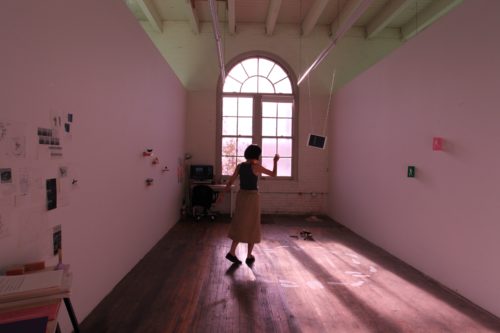
For example, Sayaka Ohata’s project, “For My Ancestors”, was inspired by attending a traditional Japanese memorial festival (Obon) in Oregon. Ohata found the experience to be uncanny in its unfamiliar rendering of a very personally familiar ceremony, and sought to create an immersive installation in her studio at Yale Union based on this feeling. In its presented form, “For My Ancestors” saw a constellation of found and created symbolic materials including sculptures made from vegetables which decayed over time, an animated video suspended from the ceiling, an artist book, and footstep silhouette cutouts on the floor mimicking the circular motion of an Obon dance. These objects filled Ohata’s studio bathed in a soft pink light, acting as tools to suggest the passage of spirits between worlds.
As another example of one of the artists’ projects, Tsubasa Kato and Yukari Hilano frequently encountered Portland’s homeless population while walking through the downtown neighborhood which used to be Japantown. At this time, the local news was also reporting on a homeless encampment along the river which was being dismantled, leaving many of its residents without shelter.
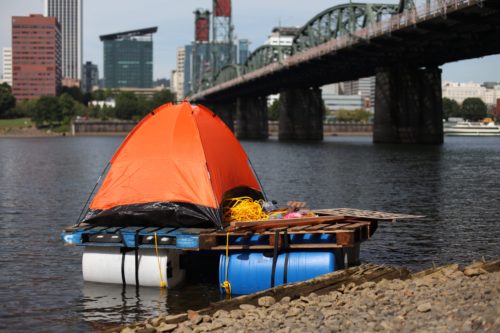
Kato and Hilano began building a floating raft structure, crafted from empty plastic barrels, wood pallets, and a camping tent. One morning last August, the raft emerged onto the Willamette River in downtown Portland for all the city to see. With Kato himself paddling upstream, passing traffic on the bridges, esplanade and river could glimpse at the raft with it’s familiar construction recalling the homeless encampment shelters which are frequently uprooted and displaced. From the raft, Kato displayed a QR code sign leading curious spectators to geographic coordinates online which placed the raft at it’s specific locale- but displayed routes of possibility to the rest of the world via the river.
These, and the rest of the artists’ projects, were each eventually presented to the public at the End of Summer open studio event on August 28th 2016. The open studio was an occasion on which diverse segments of Portland’s creative community came together to see art projects which presented new historical, cultural and perceptual perspectives on their own city.
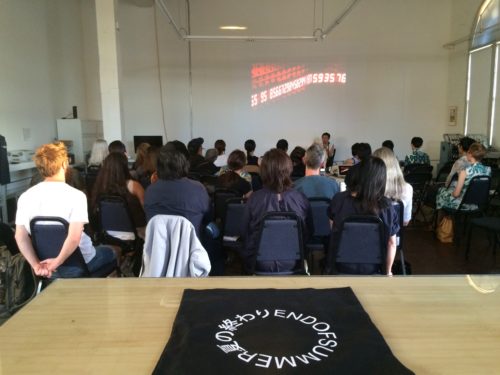
The lecture series, also held at Yale Union, hosted three guest speakers to present on subjects which further explored the themes of cross-cultural connection, critically engaged artistic practice, and Japanese art history and aesthetics. James Jack, Artist and Postdoctoral Fellow at Social Art Lab, Kyushu University, presented on points of historical interaction between Japan and the U.S. through the viewpoint of an artist. Yukie Kamiya, Director of Japan Society Gallery, discussed themes of time, site specificity and the evolving history of Japanese museums. Yuriko Saito, Professor of Philosophy at Rhode Island School of Design, provided a thorough introduction to “Everyday Aesthetics”, a field of philosophy drawing from Japanese aesthetics which she has pioneered.
Each of the lectures were open to the public, providing Portland with the unique opportunity to hear from accomplished art scholars who they may not typically have access to. The subject matter of the lectures were also unusual to the contemporary art discourse within Portland, and part of the benefit we hope End of Summer has for Portland is expanded consciousness and interest in Japanese/East Asian culture and perspectives.
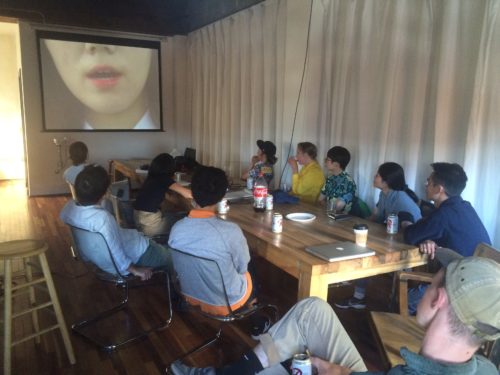
On the final day of the program, we held a roundtable discussion at Yale Union with all of the Japanese artists and one prominent Portland arts writer. This discussion enabled us to collectively share our impressions of the month-long experience. The artists discussed what they felt they gained from participating in the program, and also shared their thoughts on the current state of contemporary art in Japan. Most crucially perhaps, we discussed potential next steps for End of Summer, and how it can continue to advance its mission of cross-cultural artistic exchange.


